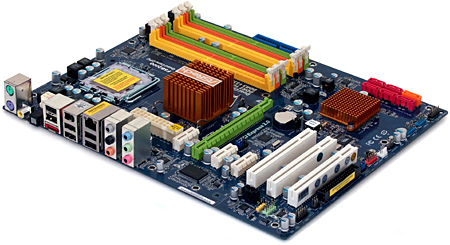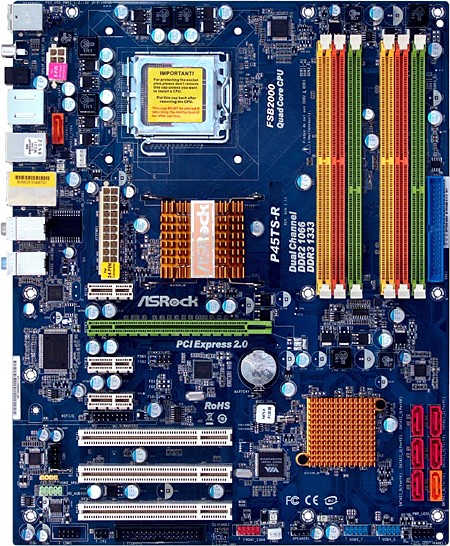11-Way P45 Motherboard Shootout
ASRock P45TS-R
Just as the formerly-introduced P45R2000-WiFi attempts to bring high-end features to the mainstream market, ASRock’s P45TS-R attempts to bring mainstream features to the low-cost market. Though it’s yet to be seen in discount Web stores, an estimated web price of around $120 brings buyers such niceties as IEEE-1394 FireWire, onboard digital audio outputs, enough analog jacks to support 7.1 surround without sacrificing microphone or line level inputs, and the reliability benefit of solid capacitors in all locations.
Like its better-featured brother, the P45TS-R targets the widest number of possible buyers by supporting the builder’s choice of DDR2 or DDR3 modules, but focuses primarily on DDR2 with four slots for the older style memory. Cost efficiency is seen in the simple chipset sinks where anything more elaborate is not normally required, while a four-phase voltage regulator reminds everyone that this really is a low-cost part.
The P45TS-R doesn’t include a second x16 slot to share the sixteen PCI Express 2.0 pathways in Crossfire mode, but it also doesn’t suffer the inconvenience of a selector card between the slots. One of three x1 slots is found in the same location as the more elaborate motherboard’s second graphics slot, and users can add an x1 card to any or all of these without sacrificing pathways to the x16 slot.
As with the P45R2000-WiFi, ASRock has economized the P45TS-R slightly by putting connectors in odd locations to facilitate a simplified circuit design. The rear-panel eSATA port for example isn’t connected to anything, as ASRock expects builders to run a cable internally from the orange connector on the bottom-front corner to the likewise connector on the top-rear corner. Also, the 24-pin ATX/EPS main power connector is located on the “wrong side” of the chipset/RAM, forcing builders to rout this cable in an “ugly” way that could hinder airflow. And just when we thought the bottom-rear corner was the worst possible place to put a front-panel audio header, ASRock proved us wrong by moving theirs up by only around an inch, making it too high to reach from the bottom and too low to reach from the top.
With all the layout complaints, one might make the mistake that we didn’t like the P45TS-R, which is far from true. But rather than reveal any test data too early in this article, we can point to good layout traits like the Ultra ATA connector at the front edge above the motherboard’s center line for easy reach to upper-bay devices, and the six Serial ATA connectors that face outward rather than upward to ease placement in tight cases.
Of course the Serial ATA connectors will get in the way of full-length PCI cards, but we find it extremely unlikely that anyone considering this value-performance part will use it with server components.
Six USB 2.0 ports are available internally to connect front-panel devices, but two of these are found on a WiFi mini-card header between the third PCI Express x1 and top PCI slot.
Get Tom's Hardware's best news and in-depth reviews, straight to your inbox.
XP users who wish to add AHCI or RAID mode to their installation will be disappointed to find the floppy header beneath the P45TS-R’s lowest PCI slot, but ASRock probably had Vista users in mind with this layout.
Current page: ASRock P45TS-R
Prev Page P45R2000-WiFi Software And Accessories Next Page P45TS-R Onboard Devices-
nickchalk Where are the lower price P45 M/B ?Reply
Asus P5Q pro is out for €110 and P5Q deluxe for €165 the price difference is about 70$ in Greece. -
Proximon I suppose I can get some good from having read this. Did you get paid by the word? Maybe next time you could just put together a complete features chart so that we can have some convenient comparison? You know, so someone could go to a chart and see at a glance which boards had eSATA or firewire, or 8 USB.Reply
-
JPForums I'd rather have the overabundance of information than a lack of information. Presentation could use a little refining (I.E. comparison charts and the likes), but having the relevant information available at least is a good thing.Reply -
the introduction and specifics are nice, the comparision isn't. so, why don't you test with an 8500 or qx9650? 6850 are outdated... and a mobo handling a c2d doesn't mean it can handle a quad too, see P5K for example (it stinks when it comes to a q6600).Reply
-
Crashman procithe introduction and specifics are nice, the comparision isn't. so, why don't you test with an 8500 or qx9650? 6850 are outdated... and a mobo handling a c2d doesn't mean it can handle a quad too, see P5K for example (it stinks when it comes to a q6600).Reply
Tom's Hardware wants the performance of current articles to reflect that of recent articles, so a "standard test platform" was chosen a while ago. It will get updated, but probably not before the new socket becomes widely available. -
zenmaster I would have liked to see something such as a P35 and an X48 as controls to help analyze the P45 Performance.Reply
In otherwords, What is the P45 Gaining me over the older P35.
What would I gain by going to the X48. (Or Lose) -
Crashman zenmasterI would have liked to see something such as a P35 and an X48 as controls to help analyze the P45 Performance.In otherwords, What is the P45 Gaining me over the older P35.What would I gain by going to the X48. (Or Lose)http://www.tomshardware.com/reviews/intel-p45-chipset,1961.htmlReply -
johnbilicki The first 17 pages were filled with nothing but junk from ASUS. Do us a favor: don't even bother featuring or *MENTIONING* anything for any reason from a company that refuses to RMA 200-400 dollar brand new motherboards with anything other then used and usually broken junk. It destroyed my enthusiasm for the article.Reply -
dobby nickchalkWhere are the lower price P45 M/B ?Asus P5Q pro is out for €110 and P5Q deluxe for €165 the price difference is about 70$ in Greece.Reply
the p5q PRo is a p43 board, i should know i have one


